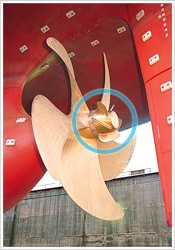Was The World’s ‘Northern-Most Island’ Erased From Charts?
by Kevin Hamilton (University of Hawaii) In 2021, an expedition off the icy northern Greenland coast spotted what appeared to be a previously uncharted island. It was small and gravelly,...


– by Daniel Kane, Propulsion Dynamics
A half decade ago, hull performance sounded like some esoteric concept, but the ban on tributyl tin (TBT) coatings and increasing bunker prices has led to the emergence of companies specializing in hull and propeller performance monitoring.
Nowadays, there is widespread data from many academic and industry sources on the ship performance effects of:
Evidence gathered from full scale tests on over 300 ocean-going vessels from one company has shed light on these aspects of hull performance in relation to the clean smooth hull (physical trials model).
By calculating speed through water (true speed through water cannot be measured by the log or DGPS), and full correction for wind, waves, swell, sea current, draft/trim, and fuel oil quality, what we find is that the basic roughness made up of old hull coating systems can cause a significant performance loss on all ship types, but especially containerships with their long vertical sides and relatively small flat bottoms.
Ships entering their second or third 5-year docking can significantly improve fuel efficiency by white-metal blasting (SA2.5) of the hull (most suppliers of Antifouling and Foul Release hull coatings now suggest white metal blasting for smoothest hull performance). Mediocre coating application or adverse weather conditions in drydock and/or slow steaming and long idle times exacerbate hull fouling. Also, the effects of slime and onset of fouling appear as a continuous increase of the ship’s resistance over a time function, the moment the ship hits the water.


Furthermore, the propeller fouling appears somewhat dependent on propeller composition and time in port, fouling pressure, vessel speed et cetera. Therefore, as an example, if a VLCC is consuming 15 more tons per day (than at design speed and draft in relation to the clean smooth hull and propeller performance) 5 tons per day could be the basic roughness (all hull coating systems experience some roughening over time, even if no hull cleanings in service) another 7 tons per day could be the fouling of hull and 3 tons per day could be the propeller friction. For another VLCC (or for that matter, another ship type), it could be completely different proportions of hull roughness, hull fouling and propeller friction.
Shipowners outsourcing full-scale performance tests, such as the CASPER® Service on a fleetwide basis typically conduct ‘super polishing’ of the propeller more often (up to 3 times a year, depending on daily fuel oil consumption, and hull cleaning at an EARLY enough time to gently remove slime and marine growth, but not scratch the hull coating as well as evaluate the effect of different hull cleaning devices. Good results are being seen with the new hull cleaning robots. [Another take-away is more frequent propeller polishing and super polishing of the propeller saves an additional 1-2% over normal propeller polishing]. The drop in hull resistance after docking or husbandry immediately tells the speed and fuel gains. The development of hull and propeller resistance after cleaning indicates if the hull was cleaned at the right time.




Lastly is the blasting of the hulls in dock – many shipowners now square off larger portions of the hull for blasting which is more effective to reduce basic hull roughness “macroroughness” (compared to lots of small blasted areas). Shipowners using a hull performance monitoring system are also able to easily see the short term and long term differences in real fuel efficiency between hull coating systems and also the apparent fuel savings of various energy saving devices, such as the Propeller Boss Cap Fin which is saving 3%-5% in fuel (at design speed and draft) on Aframax tankers.
It is now possible to establish a hull and propeller performance monitoring system for assessing the condition of the fleet, and benchmark as well as point out a summary of recommendations for each ship. Published data about technical fuel efficiency savings and Return on Investment in less than 1 year by use of CASPER® are written in the Carbon Disclosure Project of Teekay Shipping as well as write ups in the Environmental Reports of other shipowners such as Norden A/S and China Navigation.
Out on the horizon is the ‘target hull resistance’ for each ship. Working closely with shipowners – knowing age of ship, time out of dock and operational patterns, it is possible to set a target FOC for each ship type and improve year over year, however, this is usually not possible from analyzing noon data alone. The speed log error and changing conditions over 24 hour noon reports usually show too much scatter to utilize for robust hull performance decision making.


Learn more at the International Congress on Marine Corrosion and Fouling in Seattle on June 25-28. www.icmcf.org
Daniel Kane is Co-Founder and has been V.P. Business Development for Propulsion Dynamics Inc. since 2003. He has a Bachelor of Science Degree, Mechanical Engineering, from Cal State Los Angeles. He is co-author of the SNAME Marine Vessel Environmental Program, chapter EE1.5 Guide for Energy Optimization Measures: Hull and Propeller Operations and Maintenance. He is also a member of the advisory council to International Maritime Organization through National Association of Corrosion Engineers (NGO) on hull maintenance.
Join the gCaptain Club for curated content, insider opinions, and vibrant community discussions.


Join the 105,961 members that receive our newsletter.
Have a news tip? Let us know.
Access exclusive insights, engage in vibrant discussions, and gain perspectives from our CEO.
Sign Up




Maritime and offshore news trusted by our 105,961 members delivered daily straight to your inbox.



Essential news coupled with the finest maritime content sourced from across the globe.
Sign Up